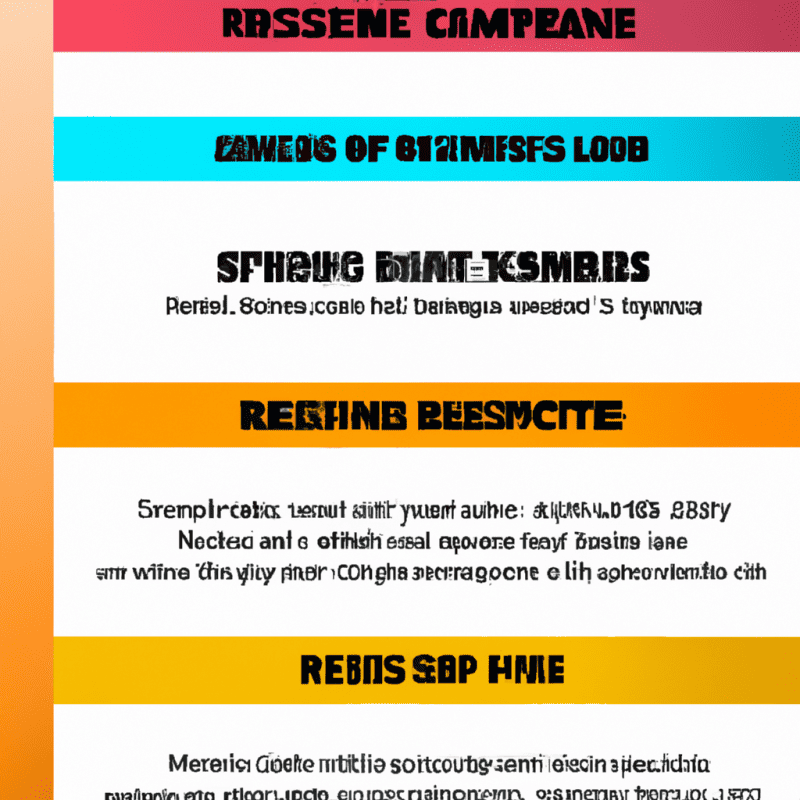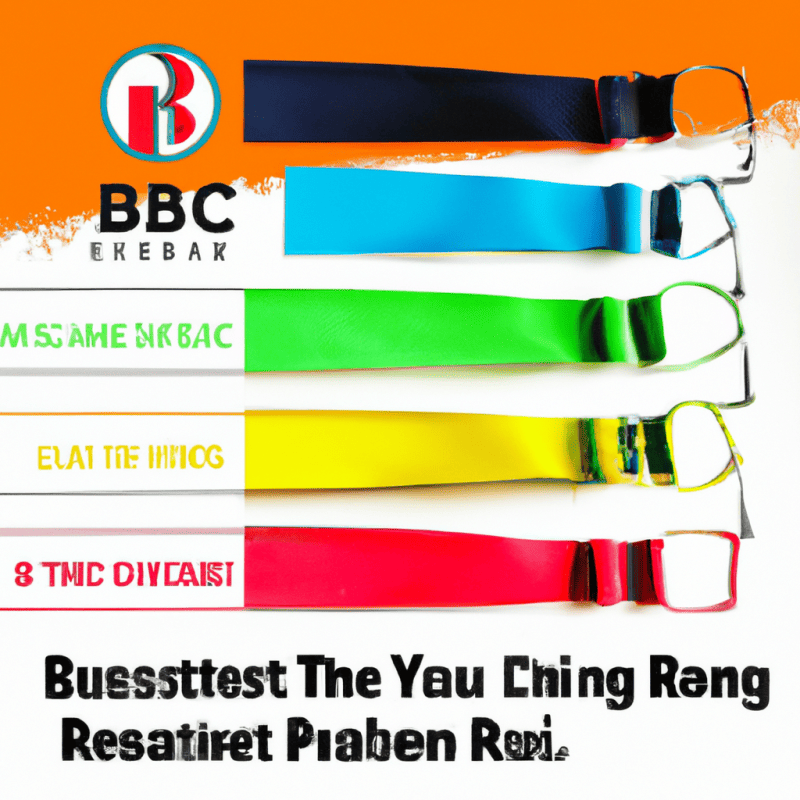resistance bands
Choosing the Right Resistance Band Color for Your Fitness Routine
When it comes to selecting a resistance band for your fitness routine, the color may seem like a small decision, but it can actually make a big difference in the effectiveness of your workout. With a rainbow of options available, it’s easy to get overwhelmed and wonder, “What color resistance band should I use?” Fear not, as this article will guide you through the process of choosing the right resistance band color for your specific fitness goals, ensuring that you get the most out of your workouts and achieve the results you desire. So, let’s put on our matching workout gear, grab our water bottles, and get ready to find the perfect color to take your fitness routine to the next level.
Understanding Resistance Bands
Resistance bands are a versatile and effective piece of fitness equipment that can be used for various workouts and training routines. These bands are made of elastic material and come in different levels of resistance, allowing individuals of all fitness levels to benefit from them. Whether you are a beginner or an advanced athlete, resistance bands can help you improve strength, flexibility, and overall fitness.
What are resistance bands?
Resistance bands, also known as exercise bands or fitness bands, are elastic loops or tubes that are used to provide resistance during workouts. They are typically made from high-quality latex or rubber material, which allows them to stretch and return to their original shape. Resistance bands vary in length, thickness, and levels of resistance, allowing users to choose the band that suits their fitness level and specific goals. They can be used for a wide range of exercises, including strength training, stretching, and rehabilitation.
How do resistance bands work?
resistance bands work by providing external resistance to the muscles being targeted during an exercise. When you stretch a resistance band, it creates tension, which forces your muscles to work harder to overcome the resistance. This increased resistance helps to strengthen and tone your muscles. Unlike traditional weights, resistance bands provide a variable resistance throughout the range of motion, making them effective for building strength and stability.
Types of resistance bands
Resistance bands come in various types, each with its own unique characteristics and benefits. The most common types include loop bands, therapy bands, and tube bands.
-
Loop Bands: Also known as mini bands or circular bands, loop bands are small, closed-loop bands that can be wrapped around different body parts to provide resistance. They are commonly used for lower body exercises, such as squats and glute bridges.
-
Therapy Bands: Therapy bands, also called flat bands, are wide, flat strips of elastic material. They are often used in physical therapy and rehabilitation programs to improve strength and flexibility.
-
Tube Bands: Tube bands consist of a flexible tube with handles at both ends. They provide a wide range of resistance levels and are suitable for various workouts, including upper body exercises, Pilates, and yoga.
Each type of resistance band offers unique benefits, so choosing the right one for your needs and preferences is important.

Importance of Choosing the Right Resistance Band Color
While resistance bands come in a wide array of colors, you may wonder why the color is important when choosing a band. The color of a resistance band actually indicates its level of resistance, making it an essential factor to consider. By selecting the appropriate color, you can ensure that the band provides the right amount of resistance for your fitness level and specific goals.
Why is color important?
The color of a resistance band serves as a visual indicator of its resistance level. This makes it easier for individuals to identify and select the band that matches their strength and fitness level. When you see a specific color, you can quickly determine if the band is suitable for you or if you need to choose a different one with a higher or lower level of resistance.
Factors to consider when choosing the right resistance band color
Several factors should be taken into consideration when selecting the right resistance band color for your fitness routine:
-
Fitness Level: Consider your current fitness level and strength. If you are a beginner, it is generally recommended to start with a lighter resistance band and gradually progress to heavier ones as your muscles become stronger.
-
Specific Goals: Identify your specific fitness goals. If you aim to improve strength and build muscle, you may require a higher level of resistance. On the other hand, if you are focusing on toning and rehabilitation, a lighter band may be more suitable.
-
Exercise Type: Different exercises require varying levels of resistance. Determine the types of exercises you will be performing with the resistance band and choose a color that matches the resistance needed for those exercises.
-
Personal Preference: Ultimately, your personal preference and comfort should be taken into account. If you find a certain color appealing or motivating, go for it. Feeling good and enjoying your workouts can greatly enhance your overall fitness experience.
Benefits of using the appropriate resistance band color
Choosing the right resistance band color offers several benefits:
-
Effective Workouts: Using the appropriate resistance band color ensures that the resistance provided is suitable for your fitness level, allowing you to perform exercises with proper form and technique. This leads to more effective workouts and better results.
-
Gradual Progression: By starting with a lighter band and gradually progressing to higher levels of resistance, you can challenge your muscles and continuously improve strength and endurance.
-
Reduced Risk of Injury: Using a resistance band that matches your strength level helps reduce the risk of injury. It ensures that you are not overexerting your muscles or straining your joints.
-
Improved Motivation: Seeing your progress as you move up to heavier resistance bands can be highly motivating. It serves as a reminder of how far you have come and encourages you to keep pushing yourself.
By considering these factors and using the appropriate resistance band color, you can optimize your workouts and achieve your fitness goals more effectively.

Different Resistance Band Colors and Their Levels of Resistance
Resistance bands are typically color-coded to represent different levels of resistance. Here are some common colors and their corresponding levels of resistance:
-
Green: Green resistance bands typically offer light resistance, making them suitable for beginners or individuals who are recovering from an injury.
-
Blue: Blue resistance bands provide medium resistance. They are often used for general strength training and toning.
-
Red: Red resistance bands offer heavy resistance and are commonly used by individuals with intermediate to advanced fitness levels.
-
Black: Black resistance bands provide extra heavy resistance. They are ideal for individuals with advanced fitness levels who want to challenge their muscles even further.
-
Yellow: Yellow resistance bands offer X-heavy or maximum resistance. They are commonly used by advanced athletes or individuals who require a significant amount of resistance.
-
Purple: Purple resistance bands generally provide light to medium resistance. They are suitable for individuals who are in the early stages of strength training or rehabilitation.
-
Orange: Orange resistance bands offer light to heavy resistance. They provide a wide range of resistance levels and can be used by individuals at various fitness levels.
-
Pink: Pink resistance bands offer light to extra heavy resistance. They are suitable for individuals who want to progressively challenge their muscles and improve strength.
Matching Resistance Band Colors with Fitness Levels
To ensure an effective and safe workout, it is important to match the resistance band color with your fitness level. Here are some general guidelines on which resistance band color to choose based on your fitness level:
-
Beginners: If you are new to resistance band training or have limited strength, it is recommended to start with a light resistance band, such as green or purple. These colors provide the right amount of resistance to help you build strength gradually.
-
Intermediate: If you have some experience with resistance band training and have developed a moderate level of strength, a medium resistance band like blue or orange would be suitable. These colors offer enough resistance to challenge your muscles further.
-
Advanced: If you have been consistently training with resistance bands and have a high level of strength, you can opt for heavy resistance bands such as red or black. These colors provide the necessary resistance to keep pushing your muscles to their limits.
By selecting the resistance band color that matches your fitness level, you can ensure that your workouts are both challenging and safe.
Matching Resistance Band Colors with Specific Exercises
Different resistance band colors are often used for specific exercises to target different muscle groups or achieve varying intensity levels. Here are some examples of exercises that are commonly paired with specific resistance band colors:
-
Lower Body Exercises: For exercises that target the lower body, such as squats and lunges, green or blue resistance bands are commonly used. These colors provide enough resistance to engage the leg muscles effectively.
-
Upper Body Exercises: Red or black resistance bands are often used for upper body exercises, including bicep curls, shoulder presses, and chest presses. These colors offer the heavy resistance needed to challenge the muscles in the arms, shoulders, and chest.
-
Full Body Exercises: Orange or yellow resistance bands are suitable for full body exercises that engage multiple muscle groups simultaneously. They provide a wide range of resistance levels to accommodate different movements and intensities.
-
Pilates and Yoga Exercises: Purple or pink resistance bands are commonly used in Pilates and yoga exercises. These colors offer light to medium resistance, which is ideal for controlled movements and stretching.
-
Rehabilitation Exercises: Individuals undergoing rehabilitation often use light resistance bands in green or purple colors. These colors provide gentle resistance that helps rebuild strength and flexibility without causing further strain.
Matching the appropriate resistance band color with specific exercises ensures that you are effectively targeting the desired muscle groups and maximizing the benefits of your workout routine.
Using Multiple Resistance Bands for Progressive Training
To continue challenging your muscles and making progress in your fitness journey, incorporating progressive training with resistance bands can be highly beneficial. Progressive training involves gradually increasing the intensity or resistance level of your workouts over time. This can be accomplished by using multiple resistance bands of different colors and levels of resistance.

Understanding progressive training
Progressive training with resistance bands involves starting with a lighter resistance band and gradually moving up to heavier ones as your strength improves. This method helps prevent muscle plateau and ensures continuous adaptation and growth.
Building strength and endurance
By using resistance bands of increasing levels of resistance, you can progressively challenge your muscles and promote strength and endurance gains. As your muscles adapt to the resistance, you can switch to heavier bands to keep pushing yourself.
Combining different resistance band colors for optimal results
To achieve optimal results and target different muscle groups effectively, using multiple resistance bands in your workouts is highly recommended. By combining bands of different colors and resistance levels, you can create varying levels of tension to challenge different muscle groups and achieve a well-rounded workout.
For example, you can pair a green resistance band for lower body exercises, a red band for upper body exercises, and an orange band for full body movements. This allows you to engage different muscle groups and progress at a pace that is challenging yet achievable.
Using multiple resistance bands for progressive training not only helps you improve strength and endurance but also keeps your workouts interesting and motivating.
Considering Personal Goals and Preferences
When choosing the right resistance band color, it is essential to consider your personal goals and preferences. Different colors may be more suitable based on the type of workout you enjoy and the specific goals you want to achieve.

Weight loss and toning
If your goal is to lose weight and tone your muscles, using resistance bands with medium to heavy resistance can be beneficial. Colors such as blue or orange would be suitable for this purpose.
Muscle building and strength
For individuals who aim to build muscle and increase strength, using resistance bands with heavy to extra heavy resistance is recommended. Red, black, or pink bands are ideal for targeting specific muscle groups and promoting strength gains.
Flexibility and mobility
Those focusing on improving flexibility and mobility can benefit from using resistance bands with light to medium resistance. Colors like purple or green provide gentle resistance for stretching and controlled movements.
Sport-specific training
For individuals involved in sport-specific training, incorporating resistance bands that target the specific muscle groups used in their sport can be highly beneficial. This helps improve the strength, power, and agility required for optimal performance.

Choosing favorite or visually appealing colors
While the color of a resistance band primarily represents its level of resistance, personal preference and motivation should not be overlooked. If a certain color inspires you or makes your workout more enjoyable, feel free to choose that color. Feeling motivated and excited about your workouts plays a significant role in consistency and adherence to your fitness routine.
Consulting with Fitness Professionals
If you are unsure about which resistance band color to choose or how to incorporate resistance band training into your fitness routine, it is always a good idea to seek guidance from fitness professionals.
Seeking advice from personal trainers
Personal trainers have the knowledge and expertise to assess your fitness level, goals, and limitations. They can recommend the appropriate resistance band color and provide you with a tailored workout plan to help you achieve your desired results safely and effectively.
Working with physical therapists
If you are recovering from an injury or have specific rehabilitative needs, consulting with a physical therapist is highly recommended. They can guide you in choosing the right resistance band color for your rehabilitation exercises and ensure that you are performing exercises correctly to aid in your recovery.
Getting guidance from experienced athletes
Experienced athletes who have incorporated resistance band training into their routines can offer valuable insights and recommendations. They can share their own experiences and successes, giving you guidance and motivation to achieve your fitness goals.
Seeking advice from fitness professionals helps ensure that you are using resistance bands correctly and effectively, leading to optimal results and minimizing the risk of injury.
Adjusting Resistance Band Colors as Fitness Level Improves
As you progress in your fitness journey and your strength improves, it is important to monitor your progress and adjust the resistance band colors accordingly.
Monitoring progress and increasing resistance
Regularly assessing your strength and progress allows you to determine when it is time to move up to a higher level of resistance. If exercises that were once challenging become too easy, it is a good indicator that you are ready to upgrade to a heavier resistance band.
Transitioning to higher resistance bands
When transitioning to a higher resistance band color, it is important to gradually introduce the new resistance level. Start by incorporating the new band into your workout routine and gradually replace the lighter band as your muscles adapt. This progressive approach helps prevent muscle strain or overexertion.
Avoiding plateaus in training
By periodically adjusting the resistance band color, you can avoid plateaus in your training and continue to challenge your muscles. Plateaus occur when your muscles become accustomed to a certain level of resistance, resulting in decreased progress. Changing to a higher resistance band helps break through these plateaus and ensures continued growth and improvement.
Final Tips and Considerations
When using resistance bands in your fitness routine, there are several additional tips and considerations to keep in mind:
Quality and durability of the resistance bands
Ensure that you choose high-quality resistance bands that are durably constructed. Inferior bands may break or snap during exercises, posing a risk of injury. Investing in good-quality bands ensures maximum safety and longevity.
Proper form and technique
Pay attention to your form and technique when using resistance bands. Proper alignment and execution of exercises not only maximize the effectiveness of your workouts but also prevent injuries.
Balancing resistance and control
When using resistance bands, it is important to find the balance between resistance and control. While it may be tempting to use a band with higher resistance, it is crucial to maintain control throughout the exercise. This reduces the risk of injury and allows you to target the intended muscle group effectively.
Listening to your body and avoiding overexertion
Always listen to your body and avoid overexertion. If you experience pain or discomfort, it is important to stop and assess your form or resistance level. Pushing through pain can lead to injury and setbacks in your fitness journey.
By adhering to these final tips and considerations, you can ensure a safe and effective resistance band workout routine that promotes strength, flexibility, and overall fitness.
In conclusion, understanding resistance bands and choosing the right resistance band color is crucial for a successful fitness routine. By selecting the appropriate color, considering your fitness level and goals, and consulting with fitness professionals, you can optimize your workouts and achieve desired results. Whether you are a beginner or an advanced athlete, resistance bands offer a versatile and convenient way to improve strength, flexibility, and overall fitness. So, grab your resistance bands, choose the right color, and get ready to embark on a rewarding fitness journey.

